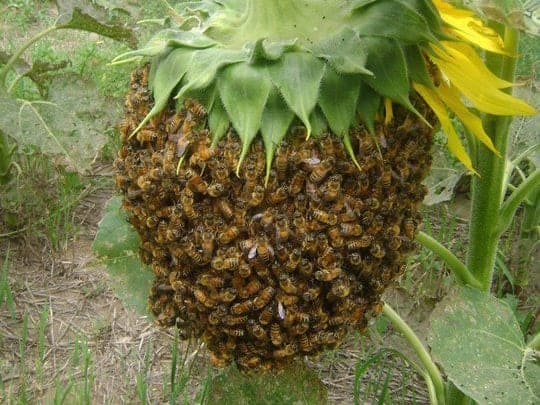How Honey Bee Clumps Withstand the Wind
Beekeepers have always been impressed with how much wind and weather a swarm can take, but some scientists can now tell us a bit more about how they do it. To keep the large clump of a swarm together, individual honeybees change their positions, fine-tuning the cluster’s shape based on external forces. A Harvard University team led by O. Peleg and J. M. Peters built a movable platform with a caged queen in the center, around which honeybees clustered in a hanging bunch. When shaken back and forth, bees moved upward, flattening out the clump and lessening its swaying. The bees might be moving based on the strain — how much each bee is pulled apart from its neighbors as the cluster swings. So the researchers made a computer simulation to determine how the bees decided where to move. When simulated bees were programmed to move to areas of higher strain, the simulation reproduced the observed flattening of the cluster. As a bee moves to a higher-strain region, the insect must bear more of the burden. So by taking one for the team, the bees ensure the clump stays intact.
Common Weed Killer (Glyphosate) May Impact Honey Bee Mortality
University of Texas/Austin scientists Erick V. S. Motta, Kasie Raymann, and Nancy A. Moran have found that a substance found in the common herbicide RoundUp perturbs the gut microbiota of honey bees. The herbicide glyphosate is expected to be innocuous to animals, including bees, because it targets an enzyme only found in plants and microorganisms. However, bees rely on a specialized gut microbiota that benefits growth and provides defense against pathogens. Using exposures similar to environmental levels, scientists show that glyphosate disrupts critical bee gut biota by reducing its size, slowing its development, increasing vulnerability to opportunistic bacteria, and impacting some biota more than others, potentially altering gut function. Having noted these changes, the experiment provides new questions concerning how they may actually affect the decline of honey bee colonies.
Royal Jelly is not just superfood, it’s super glue
Ever wondered how queen cells could hang from the bottom bars, but the larvae never fall out? Protein biochemists at the at Technische Universität Dresden have confirmed that small changes in the pH of royal jelly (usually around 4.0) result in more larvae dropping out of the queen cells. Royal jelly is not only food-eaten-on-the-ceiling, it’s glue that keeps a royal baby in an upside-down cradle. USDA/Beltsville’s Dr. Steven Cook is mentioned in this research.
Save the Bees…a little less yard work at a time!
For the second year, The Xerces Society is encouraging the spread of pollinator habitat by reducing the effort spent to rake all those leaves together with its Leave the Leaves program! Besides providing the right plants, and protecting your garden from pesticides, one of the next most valuable things you can do to support pollinators and other invertebrates is to provide them with the winter cover they need in the form of fall leaves and standing dead plant material. Frequently however, this is the hardest pill for gardeners to swallow. Xerces points out that leaves are free mulch, and are a logical outgrowth of gardener decisions to avoid chemical use, introduce native species, and enrich the soil by natural means.

